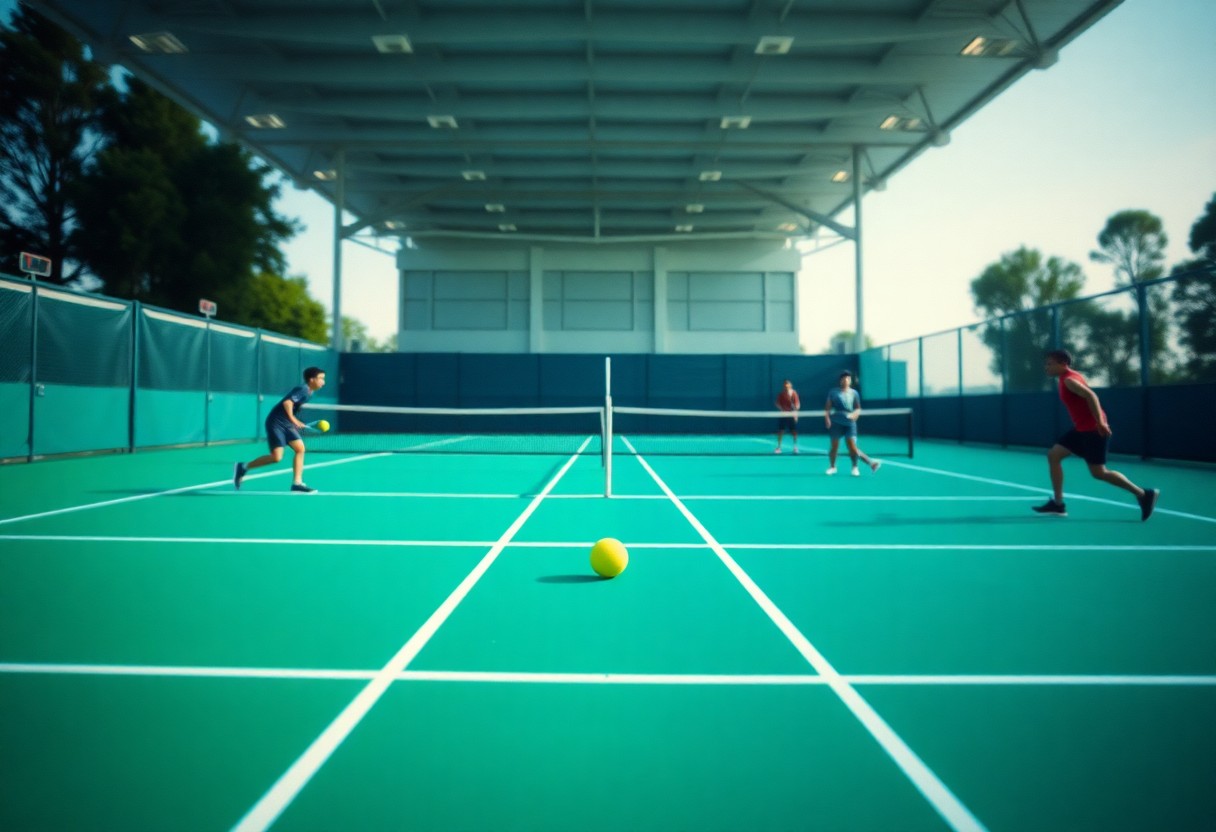Many players underestimate the power of strategic thinking in tennis. This guide offers effective tactical tips that can elevate your game and help you gain an edge over your opponents. From exploiting their weaknesses to controlling the pace of play, mastering these techniques will not only improve your performance but also enhance your overall understanding of the game.
Types of Tactical Strategies
Understanding the different types of tactical strategies is necessary for gaining an edge in tennis matches. Each strategy can exploit weaknesses in your opponent’s game while highlighting your own strengths. Offensive and defensive strategies form the core of tactical play, guiding your approach to each point. These strategies can be broken down as follows:
| Strategy Type | Description |
| Offensive | Focus on aggressive play and taking control of points. |
| Defensive | Emphasize countering your opponent’s shots effectively. |
| Counter-Attacking | Wait for opportunities to strike back after a defensive play. |
| Positional | Positioning strategically around the court for optimal angles. |
| Misdirection | Trick opponents with unexpected shot placements. |
Perceiving the dynamics of each strategy during a match enhances your ability to adapt and counter your opponent’s moves.
Offensive Strategies
Utilizing offensive strategies demands a consistent aggressive mindset. Players should focus on applying pressure through powerful serves and deep groundstrokes. Strategies like following the serve to the net and executing volley plays can further bolster offensive capabilities. Successful implementation often leads to quick points and a significant advantage in score dynamics.
Defensive Strategies
Effective defensive strategies prioritize reliability and endurance over aggression. These include maintaining a strong baseline position and employing a variety of shots like lobs and slices to disrupt an opponent’s rhythm. Anticipating returns and staying patient allows for strategic counterplay. The best defenders absorb pressure and create openings while waiting for their opponents to make mistakes.
In-depth execution of defensive strategies can drastically change the match’s flow. For instance, a well-timed lob can create opportunities to seize control of a point after being on the defensive. Players who master the art of blocking and redirecting shots often frustrate opponents, forcing them into errors. Developing a keen sense of timing and positioning further enhances these tactics, making it easier to turn defensive play into offensive opportunities.
Key Factors to Consider
Understanding your opponent’s strengths and weaknesses is vital when strategizing in tennis. Key factors to analyze include their shot preferences, fitness level, mental resilience, and adaptability to changing conditions. Additionally, consider your own playing style and how it matches up against theirs. By recognizing these elements, you can craft a game plan that plays to your advantages while exploiting their vulnerabilities.
- Opponent’s playing style
- Court surface conditions
- Personal strengths
- Game strategy
Thou should analyze these factors systematically during your match preparations.
Opponent’s Playing Style
Identifying your opponent’s playing style allows you to anticipate their next move. Whether they favor aggressive baselining or serve-and-volley tactics, adjusting your game to counteract these approaches can shift the match in your favor. For instance, against a powerful hitter, positioning and defensive play may be key.
Court Surface Conditions
The court surface conditions significantly influence gameplay dynamics. Different surfaces like grass, clay, and hard courts affect ball speed and bounce. On clay, for example, rallies tend to be longer, rewarding players with stamina and strategic thinking. In contrast, hard courts favor quick reflexes and power. Understanding these variances will help you adjust your technique accordingly.
Moreover, consider how external conditions such as wind or humidity may impact play. Wind can disrupt shot accuracy and consistency, while humidity affects player stamina and grip. For instance, players accustomed to dry hard courts may struggle on humid days where surfaces feel slippery. Adapting tactics to these conditions, such as choosing a more conservative shot selection on windy days, can provide a significant edge in matches. Thou must continually assess and adapt to the playing environment to outsmart your competition.
Essential Tips for Outsmarting Your Opponent
To elevate your game and outsmart your opponent, consider these strategies:
- Analyze your opponent’s playing style
- Capitalize on their weaknesses by targeting specific areas
- Use deceptive shot placements to create opportunities
- Vary your serve speed and spins
- Stay adaptable; modify your game plan as needed
The best players recognize patterns and adjust accordingly. Knowing your opponent’s tendencies can lead to decisive victories.
Mental Game Techniques
Strengthening your mental game is necessary in tennis. Techniques such as visualization can enhance focus, allowing you to picture successful plays and routines before executing them. Practicing mindfulness helps to maintain concentration during high-pressure situations, enabling you to remain calm and composed when faced with adversity. Mental fortitude often separates the good from the great.
Physical Conditioning Insights
Physical conditioning plays a vital role in outsmarting your opponent. A well-rounded fitness regimen that includes strength, agility, and endurance training can significantly improve your on-court performance. Exercises like interval sprints enhance cardio, while plyometric drills develop explosive power needed for quick directional changes. Incorporating flexibility training minimizes injury risk and increases range of motion, allowing for more effective shot execution.
Incorporating specific exercises into your regular routine can make a noticeable difference. For example, stamina training through long-distance running or cycling bolsters endurance during lengthy matches, enabling you to maintain a competitive edge. Strength training, focusing on leg and core muscles, enhances stability, granting better balance and control over shots. Together, these elements contribute to a robust conditioning strategy that can help you consistently outsmart opponents on the court.
Step-by-Step Guide to Tactical Play
| Key Stages | Description |
|---|---|
| 1. Pre-Match Analysis | Assess your opponent’s strengths, weaknesses, and playing style to shape your strategy. |
| 2. Set Objectives | Define clear goals for the match based on your analysis, such as targeting specific shots or areas of the court. |
| 3. In-Match Adaptation | Continuously evaluate the match dynamics and adjust your tactics as necessary. |
| 4. Post-Match Reflection | Review your performance and analyze outcomes to improve future tactical decisions. |
Analyzing the Match
Before stepping onto the court, conduct a thorough analysis of your opponent’s game. Focus on their favored shots, court positioning, and response patterns under pressure. This insight can help identify weak points, such as a lack of mobility or difficulty with specific shot types, which you can exploit during play. Use observation from previous matches or practice sessions to compile an effective tactical plan tailored to your opponent’s unique style.
Implementing Tactics During Play
Once the match begins, implementing your tactical plan requires focus and flexibility. Stay alert to your opponent’s reactions and adjust your shots accordingly, whether it’s changing the pace, altering your angles, or mixing spins to disrupt their rhythm. Utilize positioning to control the court and force your opponent into uncomfortable areas. Frequent evaluation of the match progress will aid in refining your tactics on-the-fly for optimal effectiveness.
For effective implementation, prioritize shot selection based on situational demands. For example, if your opponent consistently struggles with high topspin shots, incorporate them regularly to gain an advantage. Pay attention to their footwork, and if they show signs of fatigue or hesitation, seize the opportunity to play aggressively. Experimenting with variations in your serves can also unsettle your opponent and keep them guessing, ultimately leading to openings for decisive points.
Pros and Cons of Different Tactics
| Pros | Cons |
|---|---|
| Can dominate rallies with aggressive shots | Higher risk of unforced errors |
| Forces opponents into a defensive position | May require intensive physical stamina |
| Can dictate the pace of the match | Vulnerability to counterattacks |
| Builds mental pressure on the opponent | May lead to overcommitment on shots |
| Creates opportunities for quick points | Less effective against consistent defenders |
| Increases crowd engagement and support | Can cause exhaustion in long matches |
| Promotes a dynamic playing style | Potential for tactical inconsistency |
| Boosts player confidence when successful | Requires precise shot-making skills |
| Allows for strategic placement of shots | Less predictable for opponents |
| Can exploit opponent’s weaknesses effectively | May lead to reckless play without discipline |
Advantages of Aggressive Play
Aggressive play can overwhelm opponents by maintaining offensive pressure. It allows players to dictate points, capitalize on weak returns, and finish rallies quickly, minimizing the chance for opponents to regain control. This style not only poses a threat with powerful serves and groundstrokes but also often draws errors by forcing the opponent into uncomfortable positions. As a result, aggressive players frequently enjoy a psychological edge as they establish dominance throughout the match.
Disadvantages of Defensive Techniques
While utilizing defensive techniques can lead to a stable, patient game, it comes with drawbacks. Defenders often risk losing momentum, as waiting for the opponent’s mistakes can make matches less dynamic. Additionally, relying too heavily on a defensive strategy may render players reactive rather than proactive, ultimately allowing the opponent to seize the initiative.
Defensive play also highlights the potential for disengagement in rallies. Players adopt a less aggressive stance, waiting to return volleys instead of creating opportunities. This approach can lead to prolonged exchanges, taxing stamina and concentration. Over time, the tendency to play safe may foster feelings of frustration or even defeatism, thus hindering performance when a bold response is needed. Ultimately, while a well-executed defense is necessary at times, an overreliance on it can stifle a player’s potential to capitalize on openings for scoring.
Common Mistakes to Avoid
In tennis, even small mistakes can lead to significant losses. Players often fall into traps that hinder their strategic play. This section highlights common pitfalls that can compromise your performance, aiming to refine your approach and empower your decision-making on the court.
Overthinking Your Moves
Second-guessing can lead to hesitation and missed opportunities. While analysis is important, overthinking every shot can exhaust your mental energy and disrupt fluid play. Focus on trusting your instincts and training, which enables quicker, more decisive actions that improve your overall game.
Ignoring Opponent’s Trends
Observing your opponent’s patterns is a key factor in gaining the upper hand. Players often make the mistake of focusing solely on their own strategy while neglecting to analyze their opponent’s preferred shots and weaknesses. For example, if your opponent consistently struggles with backhands, targeting that area can shift the match in your favor. Keeping a close eye on how they respond to different shots and adapting your game plan accordingly can provide vital insights. Being attuned to these trends allows you to strategize effectively, countering their strengths while exploiting their vulnerabilities.
Summing up
Ultimately, mastering tactical tennis requires a combination of strategic thinking, anticipation of your opponent’s moves, and adaptability during play. By applying the tips outlined, players can increase their effectiveness on the court, using deception and positioning to outmaneuver adversaries. Developing a keen sense of timing and leveraging situational awareness can significantly enhance competitive performance. With dedicated practice, these tactics will not only outsmart opponents but also elevate overall gameplay.
FAQ
Q: What are some key tactics to outsmart my opponent in tennis?
A: Focus on exploiting your opponent’s weaknesses. Observe their footwork, shot preferences, and court positioning. Use varied shot placements, spins, and speeds to disrupt their rhythm and create openings for winning shots.
Q: How can I improve my mental game to gain an advantage?
A: Practicing visualization techniques can enhance your focus and confidence. During matches, stay composed and control your emotions. Develop a pre-serve routine to help maintain consistency and concentration throughout the match.
Q: What role does physical fitness play in tactical tennis?
A: Physical fitness improves your stamina, speed, and agility on the court, allowing you to respond effectively to your opponent’s shots. Regular conditioning enhances your ability to maintain a high level of performance during long rallies and matches.




